 Certain roadways and portions of the road are more dangerous than others. When driving in these areas, you are at increased risk for being involved in a collision. You should be aware of these conditions and adjust your driving to appropriately mitigate these increased risks.
Certain roadways and portions of the road are more dangerous than others. When driving in these areas, you are at increased risk for being involved in a collision. You should be aware of these conditions and adjust your driving to appropriately mitigate these increased risks.
Intersections
 Most collisions in urban areas occur at intersections. Because of the danger presented by intersections, it is very important that drivers approach them with caution and make an extra effort to be aware of what is happening in and around the intersection. It is also important that drivers watch out for pedestrians, bicycles, persons running red lights and persons starting left-hand turns. Be aware of the traffic signals, signs and potential hazards as you approach the intersection.
Most collisions in urban areas occur at intersections. Because of the danger presented by intersections, it is very important that drivers approach them with caution and make an extra effort to be aware of what is happening in and around the intersection. It is also important that drivers watch out for pedestrians, bicycles, persons running red lights and persons starting left-hand turns. Be aware of the traffic signals, signs and potential hazards as you approach the intersection.
- Crashes at intersections are frequently caused by:
- Drivers disobeying stop signs and red lights and
- Violating the right-of-way of other drivers.
- It is dangerous to pass another vehicle where someone is likely to enter or cross the road. In an intersection, the vehicle you are passing may block your view of people, cars, motorcycles, bicycles or trains.
- It is dangerous, although not explicitly illegal, to change lanes in an intersection. You could be cited for making an unsafe lane change if, in the opinion of the law enforcement officer, your lane change was hazardous for conditions.
- You should scan for traffic controls and prohibitive signs as you approach intersections so that you are ready to respond before you reach the intersection. You should always obey the signs and signals at controlled intersections and not assume that other drivers will do so. Common traffic controls found at intersections include:
- Flashing and non-flashing signal lights and arrows
- Stop and yield signs
- Signs controlling U turns, left turns and right turns
- Signs designating specific lanes for left, right, and U turns and straight through traffic
- Signs directing traffic
- Right-of-way rules help people drive safely and in an orderly manner. These rules go along with courtesy and common sense. Bicycles, scooters and pedestrians must obey right- of-way rules too. Never insist on taking the right-of-way.
Note: You should not excessively yield your right-of-way or insist on always letting others go ahead of you because it can cause traffic delays and cause other drivers to become angry.
- At intersections controlled by signals, do not enter the intersection on a green light until all vehicles and pedestrians are out of the intersection.
- You should not enter an intersection on a red light, except when making a permitted left or right turn.
- You should not enter an intersection on a yellow light (solid or arrow), unless it is unsafe for you to stop.
- If you can’t stop safely, look out for vehicles that may enter the intersection when the light changes.
- At intersections without signal lights, STOP or YIELD signs, slow down and be ready to stop.
- Yield to vehicles already in the intersection or just entering it. Yield to vehicles that arrive before you or to the vehicle on your right if it reaches the intersection at the same time as your vehicle.
- At a “T” intersection, vehicles on the through road have the right-of-way.
- If you cannot see clearly 100 ft. in both directions when approaching an uncontrolled intersection (a blind intersection), you should not be driving faster than 15 MPH. This will allow you time to stop if a vehicle pulls out suddenly.
- In an uncontrolled intersection where your view is obstructed by parked cars, trees, bushes, buildings or other objects, you should stop before entering the intersection and slowly inch forward until you can see if there is cross-traffic before proceeding through the intersection.
Hill and Curves
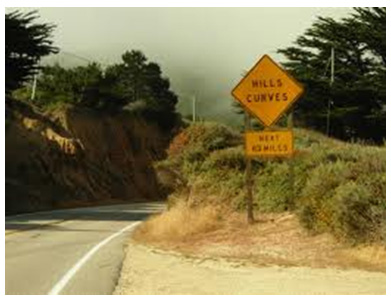 Hills and curves create situations that are hazardous by:
Hills and curves create situations that are hazardous by:
- Blocking your view ahead and the view of other drivers
- Causing vehicles to move slower or faster than is safe.
When approaching a curve in the road or hill which blocks your view of the road ahead, slow down so you can stop, if necessary.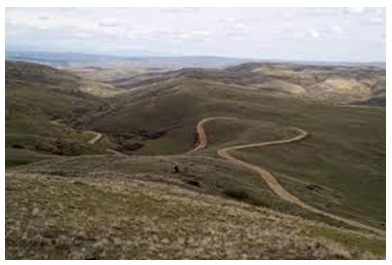
You must be able to see at least one-third of a mile ahead to pass safely. Any time your view is blocked by a hill or curve, you should assume that there is an oncoming car just out of sight.
Note that on curves there is a strong outward pull on your vehicle.
- You should cautiously approach curves, particularly when the road may be slippery due to rain, mud, snow, wet leaves or gravel.
- You should obey warning speed limits on curves and freeway ramps.
- If a warning speed limit is not posted, you should judge how sharp the curve is and adjust your speed before you enter the curve.
- Braking on a curve may cause you to skid.
Uphill Roadway
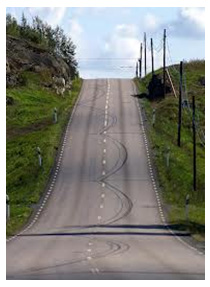 When driving uphill, the force of gravity is working against you and you may need to accelerate or change to a lower gear to maintain your speed. Be aware of vehicles behind you, which may get too close if you fail to maintain your speed when going up a hill. Change into the rightmost lane if you are driving slower than other traffic.
When driving uphill, the force of gravity is working against you and you may need to accelerate or change to a lower gear to maintain your speed. Be aware of vehicles behind you, which may get too close if you fail to maintain your speed when going up a hill. Change into the rightmost lane if you are driving slower than other traffic.
When you drive downhill the reverse is true.
- Gravity will cause you to go faster and increase your stopping distance.
- You may need to shift to a lower gear or smoothly apply your brakes to slow to a safe speed and control your vehicle.
Too much braking (riding the brake pedal) when driving down long, steep hills can cause brake failure. Therefore, it is better to use your engine to slow your vehicle when traveling down long, steep hills than to use your brakes. To do this, shift to a lower gear before you start down the hill. In most cases, you will still need to use your brakes but downshifting will lessen your amount of brake use.
Parking Lots
One of the most likely places to be involved in a property-damage only collision is in a parking lot.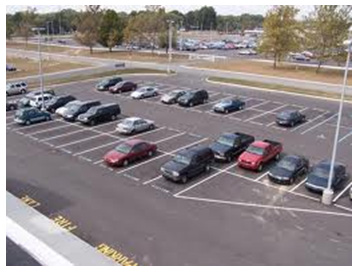
Accidents are common in parking lots because:
- Drivers are not paying attention to safe driving
- Drivers back out of parking spots
- Drivers do not think that they need to follow the rules of the road in parking lots.
- Post office parking lots usually have the highest incidence of crashes because they have the quickest turnover of parked cars.
- Some drivers seem to suspend their good judgment when looking for a parking space. They consider the traffic signs and road markings such as speed limits and STOP signs to be optional in parking lots because they think that on private property they are not subject to enforcement. Others drivers ignore the traffic lanes and cut diagonally across the lot. Note that you can be cited for driving unsafely in public parking lots by law enforcement, just like on public roadways.
- Pedestrians are also at high risk in parking lots because they must walk in the traffic lanes. Pay extra attention for pedestrians,
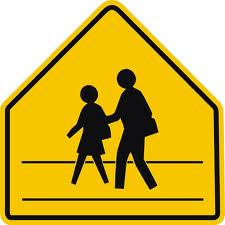 particularly small children, when driving in parking lots and when pulling out of parking spaces.
particularly small children, when driving in parking lots and when pulling out of parking spaces. - The best way to avoid a collision in a parking lot is to be aware of everything around your vehicle. Scan for cars that might be cutting diagonally across the lot and for pedestrians who may dart out from between cars. Drive slower and obey all the usual vehicle laws, signs and pavement markings when driving in a parking lot.
Urban Roadways
Urban roadways are more dangerous than open roadways for a number of reasons:
- Urban roadways have the highest number of intersections, which where accidents are the most likely to happen
- There is an increased likelihood of children and other pedestrians crossing or entering the roadway in urban areas
- Vehicles in urban areas are generally not just driving straight, they are merging, turning, stopping, or making other maneuvers that can be hazardous
- Parked vehicles and other objects obstruct your view of the roadway in urban areas. Parked vehicles in urban areas can create a
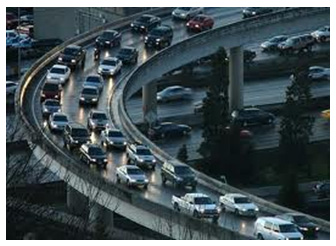 situation which is hazardous because:
situation which is hazardous because: - They may suddenly pull out from a parking space or the side of the road.
- They may obscure vehicles pulling out from alleys and driveways.
- They may have occupants who suddenly open doors or exit on left side of parked vehicles.
- Driving in freeway traffic poses special hazards. Remember to be aware of merging vehicles at freeway ramps, leave an adequate cushion of space in front of your vehicle and do not zone-out in heavy traffic; stay focused on the task at hand.
Natural Conditions
Certain natural conditions make the roadways more dangerous than at other times. These conditions include: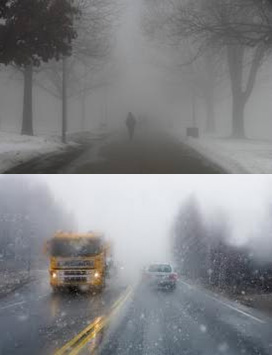
- Fog
- Dust
- Smoke
- Rain or other wet roadways
- Snow, ice, or mud
- Strong winds
You need to know what to do when you encounter these conditions to avoid collisions.
Driving at night is also more dangerous than driving during the day because your vision is more limited. You must turn your  headlights on 30 minutes after sunset and leave them on until 30 minutes before sunrise. You must also turn them on any time you can’t see at least 1,000 feet ahead. You should use your headlights during the daytime if it is difficult to see. Remember that it is always illegal to drive with only your parking lights on. Use your high beams whenever possible, as long as it is not illegal or unsafe (e.g., use them on open country when other cars are not near or on dark city streets when no other traffic would be affected by your high beams).
headlights on 30 minutes after sunset and leave them on until 30 minutes before sunrise. You must also turn them on any time you can’t see at least 1,000 feet ahead. You should use your headlights during the daytime if it is difficult to see. Remember that it is always illegal to drive with only your parking lights on. Use your high beams whenever possible, as long as it is not illegal or unsafe (e.g., use them on open country when other cars are not near or on dark city streets when no other traffic would be affected by your high beams).
Bad weather
When driving in bad weather, you should remember that the faster the speed, the less control you have over your vehicle. Rather than just following the posted speed limit, you should consider how the road conditions might affect the safe operation of your vehicle. For example, if the posted speed limit is 35 MPH, you should not drive this speed if you are traveling towards a curve on a downhill icy road. Many new drivers do not slow down to safe speeds for road conditions. This is one reason why they have more out-of-control collisions than do experienced drivers.
- The following are precautions that you must take when driving during inclement/bad weather.
- The number one rule for driving in bad weather is to slow down, particularly when approaching turns, sharp curves, and intersections.
- You should give yourself an extra-large space cushion around your vehicle particularly in front.
- Avoid making quick maneuvers such as sudden turns, braking or acceleration. Do these maneuvers gradually and slowly to avoid skidding.
- Make sure that your vehicle’s windows and lights are clean and working before driving in bad weather. Also check and make sure that the windshield wipers and defroster are properly working and that you have adequate tread on your tires.
- You should carry emergency equipment when driving in bad weather such as:
- Blankets or sleeping bags
- Non- perishable food
- Water
- Flares
- Extra clothing
- Carry a cellular phone for emergency situations, if you have one.
- Carry tire chains when you know you will be driving in the snow or when you think it might snow.
Fog
The best advice for fog is to avoid driving in it altogether. Serious pile-up collisions involving multiple vehicles frequently occur in severe fog. You should consider postponing your trip until the fog clears. If you must drive in the fog, slow down and turn your low beam headlights on (and fog lights, if you have them).
- Use your windshield wipers and defroster for best vision.
- If visibility is poor, roll down your window and turn off your radio so you can listen for vehicles that you cannot see.
- You should watch for slow moving vehicles ahead and check your rear-view mirror for vehicles approaching from the rear.
- Only use your brakes when you need to. Do not repeatedly flash your brake lights for no reason because it will confuse other drivers behind you.
- If the fog becomes so thick that you can barely see, pull completely off the road.
- Get off at an exit or rest stop, if possible, and wait for conditions to improve.
- Do not continue driving until you have better visibility
- Turn off you lights because other drivers may see your taillights and pull in behind you thinking that you are on the roadway.
- If your vehicle stalls in the fog, you should:
- Move off the roadway as quickly as possible.
- Move away from your vehicle.
- Use flasher or flares to warn others.
Dust Storms
Certain parts of California are prone to large dust storms, which can limit your visibility similar to fog. Try to avoid driving in a dust storm if you can. If you must drive, use the methods prescribed for driving in fog.
Large Fire
If smoke from a large fire such as a wildfire obstructs your ability to see the road ahead and be seen by other drivers, use the methods prescribed for driving in fog. Try to avoid driving through smoky areas if at all possible.
Wet Weather
Regardless of your driving experience, the odds are greater that you will have a collision in wet weather. A hard rain can limit your visibility of the road, traffic signs and other cars. If you must drive under such conditions, it is helpful to have the knowledge and skills to cope for these conditions. If possible, do not drive when the roadway is wet, snow-covered or icy. Wait until the weather is better or until the road has been snow plowed.
Rain
- When driving in the rain, you should:
- Obtain maximum visibility with low beam headlights and windshield wipers
- Reduce your speed below that for dry conditions
- Decrease your speed when entering a curve
- Stay on the paved portion of the highway
- Drive in the tracks of the car ahead
- Allow a greater distance between you and the car ahead
- Avoid sudden stops or turns
- Use your low-beam headlights whenever it is raining, even in the day time.
- Slow down at the first sign of rain, drizzle or snow on the road. This is when many road pavements are most slippery because oil and dust have not been washed off the roadway. If the road is slippery, it will not give your tires the traction they need to make quick stops and maneuver properly on turns. You must drive slower than you would on a dry road.
- Choose a speed consistent with the amount of water on the road to avoid hydroplaning. Hydroplaning is when your tires lose contact with the road and are riding on a thin sheet of water. To regain control, you need to take your foot off the accelerator but do not brake.
Water on the Roadway
If you must drive through water on the roadway, avoid letting water splash into the engine compartment by driving slowly. Water may stop your engine completely and leave you stranded in the middle of the water. Do not pass through strong currents that are high enough to reach the bottom of your vehicle because they can carry the vehicle away. Test your brakes after driving through deep water. Know the procedures to dry your brakes according to your vehicle make and model.
Snow or Ice
- Do not use your high beams in a snowstorm because they will reflect off of the falling snow and blind you.
- To drive safely in snow or ice you should:
- Install special tires on your vehicle.
- Make sure that you carry the correct number of chains and that they will fit your wheels. Learn how to put the chains on your vehicle before you need to use them.
- Obtain maximum visibility of the details ahead by using low beam headlights, windshield wipers and defrosters.
- Reduce speed before turns, curves and shady areas.
- Allow a greater distance in front of your vehicle for stopping
- Watch for signs warning of potentially icy conditions.
- Watch for areas in which ice is likely to collect such as on bridges.
- Avoid stopping or turning suddenly.
- Exercise caution when downshifting.
- Avoid unnecessary stops.
- When driving on roadways where snow chains are required, temporary special speed limits may be posted which you must obey. These speed limits range from 25 to 40 MPH.
- Some road surfaces are more slippery than others when wet. These roads often have warning signs. Clues to help you spot slippery roads are:
- On cold and wet days, shade from trees, buildings and under/over passes can hide spots of ice. These areas freeze first and thaw last.
- Bridges and overpasses can also hide spots of ice. They tend to freeze before the rest of the road.
- When close to the freezing point, the road is icy and may be more slippery than at colder temperatures.
- In California, we also have a special problem with “black ice.” Black ice is very difficult to see on the roadway and appears more like a wet spot than a patch of ice. Even when you see no apparent ice on the roadway, black ice may be present. Black ice is likely to form on shady parts of the roadway such as the backsides of turns or hills. Slow down and be especially careful when the weather is cold enough to form black ice.
- To help avoid skidding on slippery surfaces, you should:
- Drive more slowly and stay farther behind the vehicle ahead
- Slow down as you approach curves and intersections
- Avoid quick stops and use threshold braking as outlined earlier (unless you have antilock brakes)
- Shift to a low gear before going down steep hills.
- If you go into a skid, ease off the gas pedal, but do not brake. Turn the steering wheel in the direction you want the vehicle to go. If you can’t control your vehicle on a slippery surface, try to find something to stop you. You may have to slowly edge into a snow bank or some bushes to stop.
- Every time the outside temperature drops 10 degrees Fahrenheit, the air pressure inside your tires goes down about one or two pounds per square inch. You should check your tire pressure frequently during cold weather and add the necessary air to keep them at recommended levels of inflation at all times.
Strong Winds
String winds can blow your vehicle around, especially on bridges, when driving in the mountains and on wide-open roads. Large vehicles, such as motor homes and vehicles towing trailers are especially vulnerable to being blown off course by the wind. Tips:
- Slow down when driving in strong winds.
- Be ready for strong gusts that may cause your vehicle to be partially blown into another lane.
- Make sure to hold the steering wheel with both hands and be especially alert.
Earthquake
If an earthquake occurs while you are driving:
- Gradually decrease your speed and pull to the side of the road.
- Do not stop on or under overpasses or bridges.
- Do not park near trees or downed power lines and avoid parking near buildings.
- Stop the car and stay down on the floor until the shaking stops. Remember that aftershocks may follow the earthquake.
- Turn on your car radio and listen for broadcast of emergency advisories.
- Do not continue to drive until it is safe and avoid overpasses and bridges because they may have been weakened.
- If driving on the freeway, exit at the first opportunity if it is safe to do so.
- Cooperate with public safety officials who are guiding the traffic.


